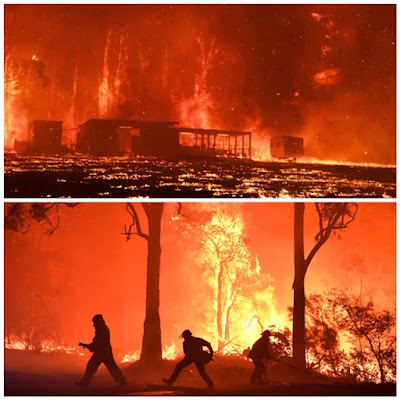The one we see around here is the grey headed flying fox and is found in the temperate south-eastern forested areas of Australia, principally east of the Great Dividing Range ie. the coastal strip between Bundaberg in Queensland south to Geelong in Victoria.
Adults have an average wingspan up to 1m (3.3 ft) and can weigh up to 1kg (2.2 lb).
They live in a variety of habitats including rain forests, woodlands and swamps. During the day, individuals reside in large roosts called colonies or 'camps' that can consist of hundreds to tens of thousands of individuals.
Grey-headed flying foxes form two different roosting camps, summer and winter.
Summer camps are used from September to April. In these camps, they establish territories, mate and reproduce.
Winter camps are used from April to September. Here the sexes are separated and most behaviour is characterized by mutual grooming. Summer camps are considered "main camps", while winter camps are referred to as "transit camps".
Around dusk, the flying foxes leave the roost and travel up to 50 km a night to feed on pollen, nectar and fruit from around 190 plant species.
Grey-headed flying foxes, along with the three other Australian flying fox species, fulfill a very important ecological role by dispersing the pollen and seeds of a wide range of native Australian plants.
They are now a subject of serious conservation concern.
Early in the last century, the species was considered abundant, with numbers estimated in the many millions. In recent years, however, evidence has been coming to light that the species is in serious decline.
They face several threats, including loss of foraging and roosting habitat as well as mass die-offs caused by extreme temperature events.
As well their roosting and foraging habits bring the species into conflict with humans where they suffer from direct killing in orchards and harassment and destruction of roosts.
Why am I talking about this?
Well sometimes these animals decide to set up their camps in urban areas.
There was once a big one in the Sydney Botanical Gardens in the CBD (downtown).
Unfortunately for some of the inhabitants of Batemans Bay, a major town just to the south of us, the flying foxes set up camp in and around a golf course and a man made parkland area filled with native trees in the middle of suburbia. Numbers were estimated at 100,000 ie. about a quarter to a fifth of the entire national population.
The noise, the smell and the continual 'rain' of guano made life very difficult for a large number of residents.
They obviously wanted them 'moved on'.
This of course brought out the 'green army' who wanted the status quo preserved. Obviously they didn't live in the area affected.
However the federal government, after some delay, enacted special environmental powers to solve the problem and the state government contributed $2.5million to set a dispersal plan in motion.
Apart from removing the vegetation from the 'camp' area, extremely loud industrial noise combined with smoke and bright lights has been employed in an effort to make the area where the flying foxes roost to be as 'uncomfortable' as possible
It's early days yet but that plan, so far, seems to be working.
We just hope they don't move up this way although we are aware there has been a 'camp' in the Brooman Forest a fair distance away to the south west of us for some time.







































